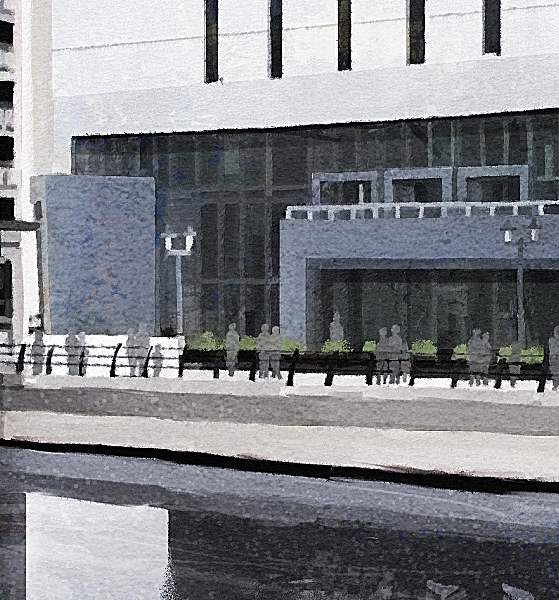Looser NPR
-
Essentialy done with Gel layers & Digital watercolour and Drip brushes.
-
Really great looking. I thought for a short moment it said "loser NPR".

One of the best NPRs in a long while.
I've never got to grips whith the Painter UI though.
Might have to try it again after seeing this.
Can you share some more of your workflow and settings for the Digital watercolour and Drip brushes? -
I think the key is not to start with Painter but rather the style you wish to replicate. Study the 'mechanics' of the mark-making and then select/customise brushes that give you the closest effect at the pixel level. If you want to replicate watercolours you need to understand the layers that have a transparent algorythm for achieving the look of overlaid washes. (Gel, overlay, screen, colorise.)
Guache / oil type styles are in my opinion a lot easier (albeit a little harder in 'look and feel') as you dont need to master transparency and can often do the paintwork on a single layer:

Use a texture overlay rather than expressing the paper texture as this will yield more realistic results.
Don't rely too much on step 'techniques' as these can generaly be easily identified from those where actual hand brushwork is involved. Use a tablet even if only a small cheap one.
Try and blur the line between traditional chemical media and digital. -
You are master, but I don't understand how you do it. Small video would be helpful...

...Example of brushes used? Do you use any kind of filters, or manual paint over everything from the beginning? -
I second the request for a quick video tutorial if you have time TV. Could this be done with Corel Painter Essentials? My trial for 11 expired, by I have Essentials as it came free with my Wacom tablet.
-
There is also a very nice package of ready made brushes from John Derry that can help with similar effects here:

Blog not found
Blogger is a blog publishing tool from Google for easily sharing your thoughts with the world. Blogger makes it simple to post text, photos and video onto your personal or team blog.
(pixlart.blogspot.com)
These examples you've posted are some of the best watercolor examples from Painter I've seen -- very natural and I would be hard pressed to see the Sketchup beneath


Best,
Jason. -
If you are looking for a 'technique' type tutorial I'm going to have to dissapoint you because I dont have one. Rather the principles descibed above need to be understood and applied in whatever way that fits the image you wish to achieve.
I think the whole point about doing NPR is producing images that have a personal feel and show your own involvement as apposed to the machine perfection of GC rendering. Simply following a technique to achieve a specific style seems to be a little counter-productive to his goal. Instead of searching for 'recipies' I think that learning the nature of 'ingredients' that contribute to an image and how these can combined in different combinations would be a more helpful way to approach this.
This keeps the process flexible and spontaneous and will help you to develop a personal 'look and feel' to your images.One tip I can give you is to paint in greyscale/monochrome in order to develop a feel for the tonal structure of an image.
Achieving both colour & tonal control at the same time is difficult when you start out. If you can't achieve a reasonable monochrome image you will struggle with images that contain mid tonal colour.As with CG rendering there is no quick way to become more proficient so you do need to spend the time to develop your personal technique.
Not sure what subset of functionality P. Esentials has but I suspect you will have everything you need without spending on the full version.
[As far as being a master I'm not so sure as I still seem to end up with more abandoned images than completed ones.]
-
@unknownuser said:
..and I would be hard pressed to see the Sketchup beneath.
For me one of the major advantages of NPR over GCR is the fact that you do not always need a detailed model on which to base an image. You can develop early design study visuals based on your (or your client's) design sketches and other image references before the design has been finalised. In this way NPR can feed into a design process at a stage when CGR cannot.
-
Great results toxicvoxel !!!!
I mostly agree on the use of overlay paper texture. The best way.
(what a username )
) -
NPR . .. I assume this doesn't refer to National Public Radio. ..
I really like the Watercolor style. This is Corel Painter only? couldn this work in Photoshop or Fotosketcher as well? Piranesi? (which I don't have yet?)
-
David_h, corel painter is the best app we know for digital painting. Ps can do miracles via overlay tricks (better than corelP) but thats all. All other solutions are ready made templates and extremely boring for our 'hobby' here. For other uses like 'time is money', its not my concern, so...

-
Maybe I just need to get out my brushes and Watercolors again. . .
-
Of course this is what you need! Good choice! BTW just do some strokes splashes and washes, scan or photo it and overlay(hardlight) over a SU raw export.

Advertisement







